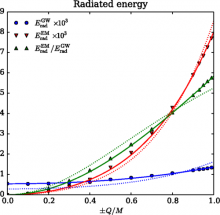
Abstract
The first fully non-linear numerical simulations of colliding charged black holes in D=4 Einstein-Maxwell theory were recently reported arXiv:1205.1063. These collisions were performed for black holes with equal charge-to-mass ratio, for which initial data can be found in closed analytic form. Here we generalize the study of collisions of charged black holes to the case of unequal charge-to-mass ratios. We focus on oppositely charged black holes, as to maximize acceleration-dependent effects. As |Q|/M increases from 0 to 0.99, we observe that the gravitational radiation emitted increases by a factor of ~ 2.7; the electromagnetic radiation emission becomes dominant for |Q|/M >~ 0.37 and at |Q|/M=0.99 is larger, by a factor of ~ 5.8, than its gravitational counterpart. We observe that these numerical results exhibit a precise and simple scaling with the charge. Furthermore, we show that the results from the numerical simulations are qualitatively captured by a simple analytic model that computes the electromagnetic dipolar radiation and the gravitational quadrupolar radiation of two non-relativistic interacting particles in Minkowski spacetime.